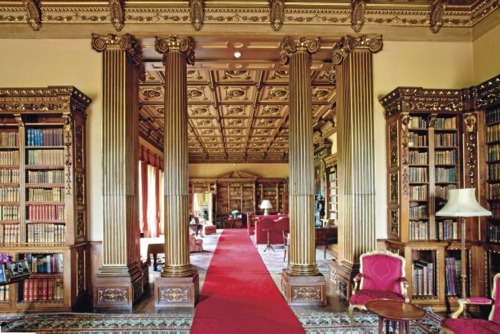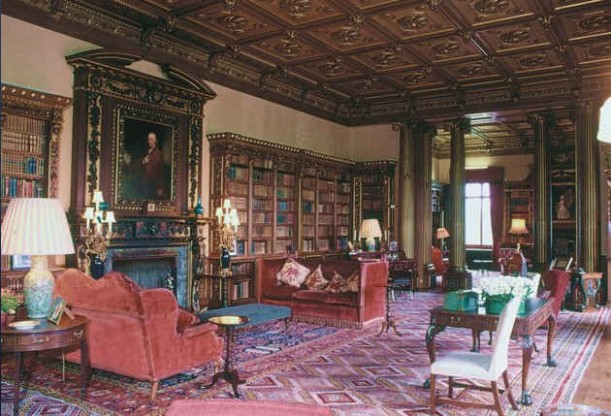September sees the return to our televisions screens of Downton Abbey in the UK and in January to the USA (more on that in the next week or two). Downton Abbey is actually the real life home of Lord Carnarvon at Highclere Castle set in a massive estate in the beautiful Hampshire countryside. Whilst the ups and downs of Lord and Lady Grantham may have us gripped to the TV screen, the real life history of Highclere Castle has more than enough to stand as a tourist attraction in its own right.

There has been a building at Highclere for over a millennia and it was mentioned in the Doomsday Book in 1086. For 400 years the estate has been in the hands of the Carnarvon family.In the mid-19th century, Sir Charles Barry remodelled what was a Georgian house into a Victorian palace for the 3rd Earl. The crowning glory was the sandstone tower, despite the prescient warnings of the land-agent who observed it was ‘pregnant with the most alarming danger to your lordship’s pocket’ but from the top of which you can see views across 4 counties. If the style of building looks familiar it is because it is because Barry was the man who oversaw the Palace of Westminster.
As shown in Downton Abbey, the aristocratic families had great difficulties financing their estates after WW1, compounded by the lack of manpower and the changing societies that democracy and universal suffrage had brought. As the country was bankrupted in WW2, repairing expensive buildings was not high on the priority list of either governments or private families and so by 2001 it was estimated that repairs to Highclere alone would cost £12 million with the national total for similar homes standing at £260 million of $500 million
Houses that were built for the tastes of centuries past are hard to maintain and extremely expensive with even the repair of a pair of period curtains well able to cost £20,000 and there are countless windows at Highclere Castle.
The family were forced to abandon their ancestral home and live in smaller buildings on the vast estate, called in a rather understated way, cottages. The upper floors were totally derelict with masonry collapsing, holes in the ceilings and roofs allowing water inside and damp to set it.
Neither was it possible to finance the repairs by selling off some of the many unique and priceless works by painters such as Van Dyck as many would not be allowed to be sold to foreign buyers and if they were, then the public would no longer be so interested in visiting the castle in the future.

The current Lord Carnarvon decided to face the problems head on. He opened up tea-rooms, made the vast grounds available for open air pop concerts and classical “Battle Proms” concerts, horse trials and historic re-enactments
A few years ago a brand new exhibition was unveiled dedicated to the cursed 5th Lord Carnarvon who sponsored and accompanied Howard Carter for the discovery and excavations of the Tutankhamen tomb and the cellars of the building now contain a replica of the original tomb.

It also includes an engaging account of the life of the ‘cursed’ 5th Earl, a pioneer of modern photography and one of Britain’s earliest demon drivers. The exhibition details many of his motoring offences, including an 1898 summons for ‘travelling at more than 12 miles per hour’ in Newbury. It was the injuries sustained through countless car crashes which led to him ending up in Egypt in the first place.
By 40, he had damaged most of his body, was suffering from serious migraines and was walking with a stick, hence his doctor’s suggestion that he should seek a warmer clime. He found Egypt and soon developed a passion for its relics.
The 5th Lord Carnarvon was an enthusiastic amateur Egyptologist, undertaking in 1907 to sponsor the excavation of nobles’ tombs in Deir el-Bahri (Thebes). Howard Carter joined him as his assistant in the excavations. He received in 1914 the concession to dig in the Valley of the Kings, in replacement of Theodore Davis who had resigned. In 1922, he and Howard Carter together opened the tomb of Tutankhamun in the Valley of the Kings, exposing treasures unsurpassed in the history of archaeology.

On 25 March 1923 Carnarvon suffered a severe mosquito bite infected by a razor cut. On 5 April, he died in the Continental-Savoy Hotel in Cairo. This led to the story of the “Curse of Tutankhamun”, the “Mummy’s Curse”. His death is most probably explained by blood poisoning (progressing to pneumonia) after accidentally shaving a mosquito bite infected with erysipelas. Carnarvon’s tomb, appropriately for an archaeologist, is located within an ancient hill fort overlooking his family seat at Beacon Hill, Burghclere, Hampshire.
At the moment of his death, it was said that all the lights went out in Cairo, while the faithful Susie, back at Highclere, cried and died. Before people worry too much, Susie was not his wife, mother or daughter but his dog. The ‘curse’ was born, along with countless Hollywood films involving mummies, murder and archaeologists.
Upstairs one of the highlights is the library which houses 6,000 volumes in the library and is where Victorian Prime Minister Disraeli did much of his planning.

Climbing from the perfectly preserved ground-floor state rooms, up through the surprisingly homely guest bedrooms on the first-floor, are the dark and threadbare labyrinth of rooms on the second-floor.
Here and there, chunks of plaster work have given way, leaving gaping holes in the ceilings. Stairs lead up to the top of the tower and its stupendous views across four counties.

Despite all this work by 2009, Highclere castle was still in dire need of major repair, with only the ground and first floors remaining usable. Water damage had caused stonework to crumble and ceilings to collapse; at least 50 rooms were uninhabitable. The 8th Earl and his family were living in a “modest cottage in the grounds”; he said his ancestors were responsible for the castle’s long-term problems.” There are several other listed buildings on the estate which are in similar condition and which the family are legally bound to maintain.

However there seems to be a happy twist in the tale of Highclere for the current Earl and Lady Carnarvon have stated that a dramatic increase in the number of paying visitors has allowed them to begin major repairs both on Highclere’s turrets and its interior. The family attributes this increase in notoriety to the on-site filming of Downton Abbey which attracts thousands of visitors each of their open days in the summer. The family is now able to live in Highclere during the winter months, but returns to their cottage in the summer, when the castle is open to the public.
With Downton Abbey set to start its 4th season and showing in over 100 countries, it is far to assume the high number of visitors to Highclere is going to continue for many years to come.

Love the show but didn’t know the amazing story behind the castle…great read!
LikeLike
Thanks Greg.
LikeLike
my kind of place to visit =)
LikeLike
Fantastic post! Really interesting. I’m glad the building has hopes for renovation. I would happily visit it. Where is this place, btw?
LikeLike
This is in the northern part of the county of Hampshire which is about 50 miles SW of London, its a a great day out.
LikeLike
Next time I’m in London, I shall travel out 🙂
LikeLike
Great piece, as always. Thanks Stephen really enjoyed reading this.
LikeLike
Since it is in Hampshire, did Jane Austen ever visit it? Might it have contributed to the fictional composite that is ‘Pemberly’? If it did, the visitors will become still more numerous.
LikeLike
That’s an interesting question and yes she did visit Highclere as she wrote in a letter how she had dined with Lord Carnarvon and he had taken her back to give her a tour of the estate.
LikeLike
Great to know the history and sad to know that so much changes with World Wars….as with all economies. Small or large, people have to deal with what they own. I am always happy to know that the owners take their history and inheritance seriously. Repairs may be one at a time …and hopefully not too late. Thanks for your excellent writing. Nancy at http://www.boyerwrites.wordpress.com
LikeLike
Interesting post Stephen, as always however it might be worth commenting that “the faithful Susie” was Carnarvon’s dog!
LikeLike
Thanks Dave. Good point, I have just edited it to make it clear that it wasn’t a desperate mistress or depressed house-maid!
LikeLike
Another excellent post Stephen! The Redhead is planning a trip back to England and northern Europe in the (hopefully) not too distant future. She wants to visit Ardverikie House (location of the Monarch of the Glen series) and also Highclere Castle. Hopefully, she will allow me some free time to hit a few pubs!
LikeLike
Thank you. Some how I entirely missed Monarch of the Glen but I know the show. Both houses are amazing and about 600 miles apart do there should be plenty of pub stops along the way!
LikeLike
Great insight! I must watch that show! My friend has been promising the lending of it on DVD. I must keep her to her word. I am going to go back and read this post after I watch the first season.
Jenni
LikeLike
Thanks! I am going to write a Downton article in the next week or two. I will try to avoid spoilers 🙂
LikeLike